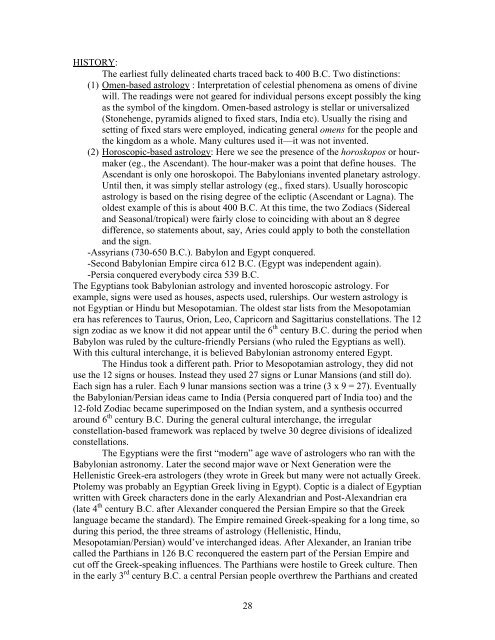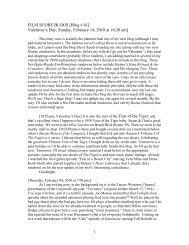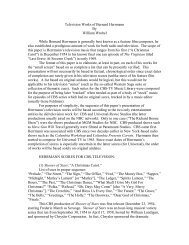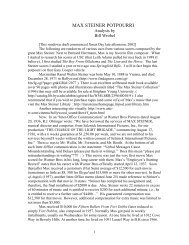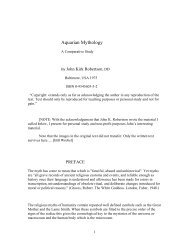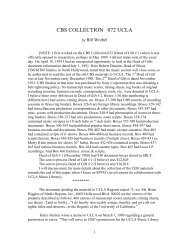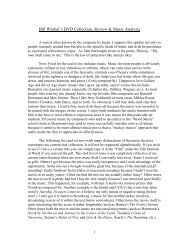OFF-TOPIC BONUS : ASTROLOGY # 2 - Film Score Rundowns
OFF-TOPIC BONUS : ASTROLOGY # 2 - Film Score Rundowns
OFF-TOPIC BONUS : ASTROLOGY # 2 - Film Score Rundowns
You also want an ePaper? Increase the reach of your titles
YUMPU automatically turns print PDFs into web optimized ePapers that Google loves.
HISTORY:<br />
The earliest fully delineated charts traced back to 400 B.C. Two distinctions:<br />
(1) Omen-based astrology : Interpretation of celestial phenomena as omens of divine<br />
will. The readings were not geared for individual persons except possibly the king<br />
as the symbol of the kingdom. Omen-based astrology is stellar or universalized<br />
(Stonehenge, pyramids aligned to fixed stars, India etc). Usually the rising and<br />
setting of fixed stars were employed, indicating general omens for the people and<br />
the kingdom as a whole. Many cultures used it—it was not invented.<br />
(2) Horoscopic-based astrology: Here we see the presence of the horoskopos or hourmaker<br />
(eg., the Ascendant). The hour-maker was a point that define houses. The<br />
Ascendant is only one horoskopoi. The Babylonians invented planetary astrology.<br />
Until then, it was simply stellar astrology (eg., fixed stars). Usually horoscopic<br />
astrology is based on the rising degree of the ecliptic (Ascendant or Lagna). The<br />
oldest example of this is about 400 B.C. At this time, the two Zodiacs (Sidereal<br />
and Seasonal/tropical) were fairly close to coinciding with about an 8 degree<br />
difference, so statements about, say, Aries could apply to both the constellation<br />
and the sign.<br />
-Assyrians (730-650 B.C.). Babylon and Egypt conquered.<br />
-Second Babylonian Empire circa 612 B.C. (Egypt was independent again).<br />
-Persia conquered everybody circa 539 B.C.<br />
The Egyptians took Babylonian astrology and invented horoscopic astrology. For<br />
example, signs were used as houses, aspects used, rulerships. Our western astrology is<br />
not Egyptian or Hindu but Mesopotamian. The oldest star lists from the Mesopotamian<br />
era has references to Taurus, Orion, Leo, Capricorn and Sagittarius constellations. The 12<br />
sign zodiac as we know it did not appear until the 6 th century B.C. during the period when<br />
Babylon was ruled by the culture-friendly Persians (who ruled the Egyptians as well).<br />
With this cultural interchange, it is believed Babylonian astronomy entered Egypt.<br />
The Hindus took a different path. Prior to Mesopotamian astrology, they did not<br />
use the 12 signs or houses. Instead they used 27 signs or Lunar Mansions (and still do).<br />
Each sign has a ruler. Each 9 lunar mansions section was a trine (3 x 9 = 27). Eventually<br />
the Babylonian/Persian ideas came to India (Persia conquered part of India too) and the<br />
12-fold Zodiac became superimposed on the Indian system, and a synthesis occurred<br />
around 6 th century B.C. During the general cultural interchange, the irregular<br />
constellation-based framework was replaced by twelve 30 degree divisions of idealized<br />
constellations.<br />
The Egyptians were the first “modern” age wave of astrologers who ran with the<br />
Babylonian astronomy. Later the second major wave or Next Generation were the<br />
Hellenistic Greek-era astrologers (they wrote in Greek but many were not actually Greek.<br />
Ptolemy was probably an Egyptian Greek living in Egypt). Coptic is a dialect of Egyptian<br />
written with Greek characters done in the early Alexandrian and Post-Alexandrian era<br />
(late 4 th century B.C. after Alexander conquered the Persian Empire so that the Greek<br />
language became the standard). The Empire remained Greek-speaking for a long time, so<br />
during this period, the three streams of astrology (Hellenistic, Hindu,<br />
Mesopotamian/Persian) would’ve interchanged ideas. After Alexander, an Iranian tribe<br />
called the Parthians in 126 B.C reconquered the eastern part of the Persian Empire and<br />
cut off the Greek-speaking influences. The Parthians were hostile to Greek culture. Then<br />
in the early 3 rd century B.C. a central Persian people overthrew the Parthians and created<br />
28


